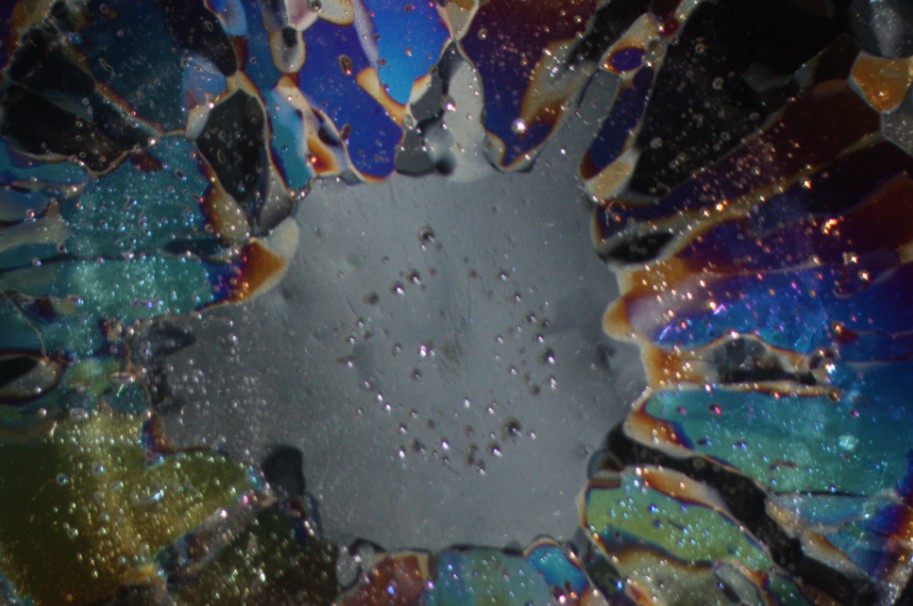Montana State University environmental scientists have found conclusive evidence that hailstones originate in biological material. MSU researcher Alex Michaud turned travesty into understanding by peeling back the onionlike layers of the crystalline compositions he collected from the Bozeman and two other Rocky Mountain hailstorms, and the results promise to increase our understanding of the role of aerosol particles in atmospheric condensation and, as a part of the bigger picture, improve our model inputs to the Earth’s energy balance.
“A hailstone is a very complex weather phenomenon, Alex Michaud, MSU doctoral student and first author of the paper, told The Speaker. “It can tell us a lot about the properties of the clouds in which it was formed.”

Michaud, who normally studies Antarctic microorganisms, took up the subject of hailstones after storms pummeled Bozeman and other parts of southwest Montana in 2010.
“While they cause lots of damage there are many things to be learned from hailstones. They’re more than just a clump of ice falling from the sky,” Michaud told us.
“This is the first paper to really show that biological material makes hailstones,” commented John Priscu, a polar scientist and professor at MSU’s Department of Land Resources and Environmental Sciences, with whom Michaud regularly works and who coauthored the report. “Despite the millions in dollars of damage the storm caused in Bozeman, the damaging hailstones provided us with a better understanding of hailstone formation, which will help us understand the role of aerosol particles in the formation of precipitation.”
 After the Montana storm, Michaud collected and stored hailstones–averaging 1.5 inches in diameter. He also collected hailstones from two other local storms that year and the next.
After the Montana storm, Michaud collected and stored hailstones–averaging 1.5 inches in diameter. He also collected hailstones from two other local storms that year and the next.
Michaud peeled back the crystalline layers of the hailstones and found that they had formed around a biological embryo.
“We can assume–quite safely, except maybe in the dead of winter–that biological material is constantly being taken up into the air,” said Michaud. “Many surfaces give off biological material such as leaf surfaces, lakes, oceans, animals, my dandruff, etc. They are emitting bacteria, fungal spores, detritus, and so forth.”
Michaud elaborated to explain that biological material in the air was not the only thing required to create hailstones.
“Certainly the atmospheric and meteorological conditions need to fit a certain set of conditions in order for a hailstorm to occur and produce hailstones. These particular conditions are best answered by a meteorologist, but suffice it to say that you need a very strong thunderstorm conditions to generate a hailstorm. So not all biological material turns into hail because meteorological conditions need to be appropriate to support hailstone formation.”
In his research, Michaud was also able to gauge the temperatures at which the hailstone embryos formed by analyzing stable isotopes in water. The temperatures at which hail froze were warm, Michaud found.
“Warm freezing temperatures–warm, sub-zero temperatures–is indicative of ice nuclei that are efficient at catalyzing ice nucleation. Water needs a template or a nucleus in order to form an ice crystal, only once water reaches ~-40C does it spontaneously freeze. So for something to freeze at warm subzero temperatures means that it provides a good template of an ice crystal, which is found in biological material much more often than abiotic–dust, minerals, etc–material.”
The study builds on previous findings that warm temperature ice nucleation indicated that biological material was likely the nuclei of hailstones.
Among past researchers in hailstones was Tina Santl Temkiv, a postdoctoral researcher at Aarhus University in Denmark, with whom Michaud consulted.
“It was very coincidental that she published two hailstone microbiology papers two years before me and we ended up at the same university for a few month,” said Michaud. “Plus, we are the only ones to work on hailstone microbiology since a 1973 paper in Nature.”
Michaud also said that hailstones were a nice model for studying atmospheric ice nucleation and cloud processes because of the way hailstones grow.
“Hail is a good model system for understanding precipitation formation and nucleation,” said Michaud. “We can trace the life history of a hailstone all the back to the part of the hailstone that was present when it was first started, the embryo. This ability to trace a hailstones life back to its beginnings, and those life history stages are layers of ice that can be peeled away–sort of like an onion–we can be more definitive in saying what was present when the embryo of the hailstone formed.”
Michaud explained to us how the new evidence could contribute to our understanding of the role of aerosol particles in the formation of precipitation.
“Aerosols are a broad term for any particle that is aloft in the atmosphere. These aerosol particles play a large role in reflecting solar energy and in cloud formation–which also reflects solar energy. So understanding how aerosols form precipitation and/or clouds will help with meteorological models and the earth’s energy balance.
“Certainly the last one is a bit of a stretch for my work, but knowing that biological ice nuclei are active in forming clouds and precipitation–rain, snow, and, now, hail–will improve the model inputs to earth’s energy balance. It’s a piece to a much bigger puzzle.”
Michaud was uncertain if the results would have any immediate practical implications.
“On improving our use of aerosol particles, I’m not too sure. In California they are trying to perform cloud seeding to increase snowpack in the Sierras to decrease drought conditions, which is through the use of particular aerosols. I don’t think I am qualified to speak to how we–the royal we, humans–can improve our use of aerosol particles.”
The report, “Biological ice nucleation initiates hailstone formation,” was authored by Alexander B. Michaud, John E. Dore, Deborah Leslie, W. Berry Lyons, David C. Sands andJohn C. Priscu, and was published in the Journal of Geophysical Research: Atmospheres.
Photo: Alex Michaud, Andrew Slaughter and Kelly Gorham, MSU
